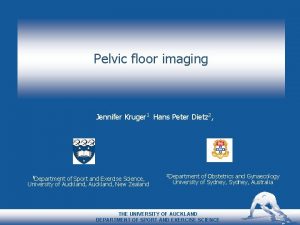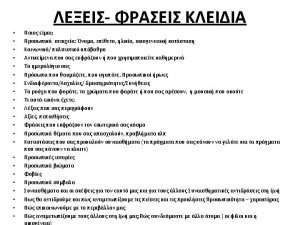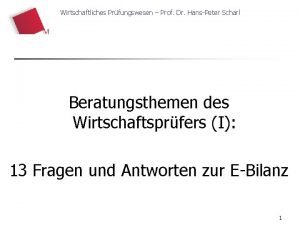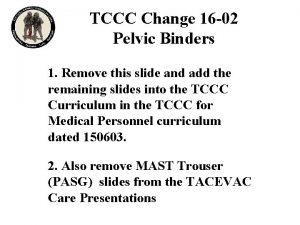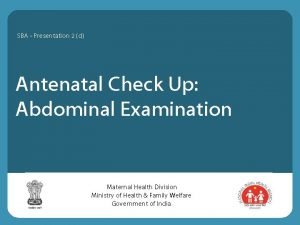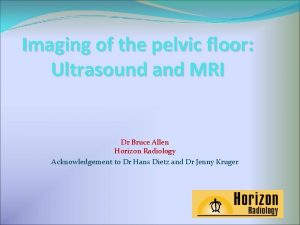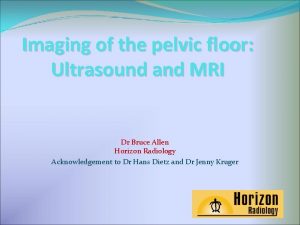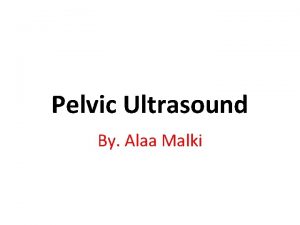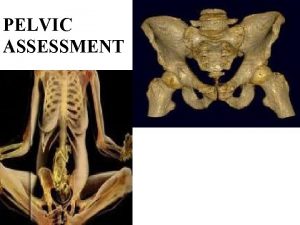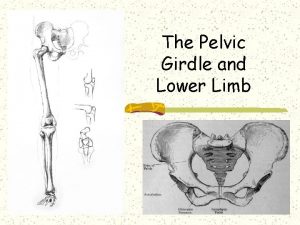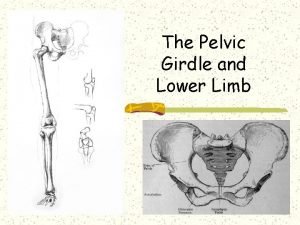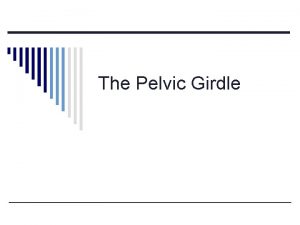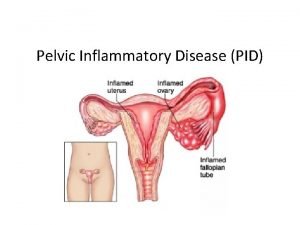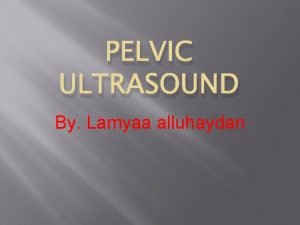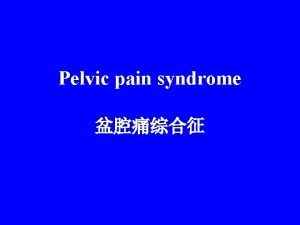Pelvic floor imaging Jennifer Kruger 1 Hans Peter


























- Slides: 26

Pelvic floor imaging Jennifer Kruger 1 Hans Peter Dietz 2, 1 Department of Sport and Exercise Science, University of Auckland, New Zealand 2 Department of Obstetrics and Gynaecology University of Sydney, Australia THE UNIVERSITY OF AUCKLAND DEPARTMENT OF SPORT AND EXERCISE SCIENCE

Outline n Pelvic floor imaging in general n 2 D imaging n General use of 3 D ultrasound n 3 D pelvic floor imaging n n n Pelvic floor function Research of pelvic floor (pf) function in elite nulliparous athletes using 3 D ultrasound. Possible clinical implications

Introduction INTRODUCTION n n n Ultrasound imaging of pelvic floor available for many years n Lack of ionizing radiation n Ease of use n Cost effectiveness Recently - capable of imaging in multiple planes, 3 D images, ‘real time’ property. These proved useful particularly obstetrics, gynaecology, paediatrics and cardiology THE UNIVERSITY OF AUCKLAND DEPARTMENT OF SPORT AND EXERCISE SCIENCE

2 D imaging 2 D Imaging n Previously 2 D/B mode ultrasound scanning used define pathology and normal function of pelvic floor. n n Abdominally, intravaginal or transperineal. Function assessed: n n n Descent of bladder, uterus and rectal ampulla during a valsalva manouevre. Images in the mid-sagittal plane. Still widely used. THE UNIVERSITY OF AUCKLAND DEPARTMENT OF SPORT AND EXERCISE SCIENCE

2 D imaging Measurements of bladder neck descent and urethral rotation. 2 D Imaging n Ultrasound images showing measurement of bladder neck descent and urethral rotation. Bladder neck descent (BND)= x-r –x-s. (Dietz et al 2006) THE UNIVERSITY OF AUCKLAND DEPARTMENT OF SPORT AND EXERCISE SCIENCE

3 D ultrasound imaging n 3 D IMAGING n n n Use of 3 D ultrasound popularised by obstetric scanning. n Volume images of the fetus Some suggestion improves diagnostic capabilities n Cleft palate n Spinal defects Gynaecological pathologies n Quantify volumes in urethra and paravaginal supports Anal canal anatomy and mammography THE UNIVERSITY OF AUCKLAND DEPARTMENT OF SPORT AND EXERCISE SCIENCE

Obstetric imaging

3 D pelvic floor imaging Recent advances in 3 D/4 D transperineal ultrasound imaging suitable for visualisation of pelvic floor muscles. 3 D Pelvic floor imaging n THE UNIVERSITY OF AUCKLAND DEPARTMENT OF SPORT AND EXERCISE SCIENCE

3 D pelvic floor imaging 3 D PELVIC FLOOR IMAGING n Display mode on ultrasound machine shows multiplanar images in sagittal, coronal and axial view and a rendered volume image. n Volume image is the integration of 2 D sectional images. n Acquisition of multiplanar images allow access to the axial plane – previously domain of magnetic resonance imaging. UNIVERSITY OF AUCKLAND DEPARTMENT OF

3 D Pelvic floor imaging 3 D pelvic floor imaging A standard acquisition screen of pelvic floor imaging as captured with a Voluson 730 expert system. The orthogonal views are seen at the top left (A plane), top right (B plane), and bottom left (C plane). The bottom right image shows a rendered volume image of the entire levator hiatus. (Dietz et al 2006) UNIVERSITY OF AUCKLAND DEPARTMENT OF

3 D pelvic floor imaging – assessing function 3 D PELVIC FLOOR IMAGING n n Unique plane of acquisition for levator hiatal area: ‘plane of minimal dimensions’ Smallest distance from the inferior edge of the symphysis pubis to the anal rectal angle n Levator hiatal area bounded by the symphysis pubis anteriorly, anal rectal angle posteriorly, puborectalis/pubococcygeus laterally. n Hiatal area measures – pelvic floor function n Rest n Maximum pelvic floor muscle contraction n Maximum valsalva n THE UNIVERSITY OF AUCKLAND DEPARTMENT OF SPORT AND EXERCISE SCIENCE

3 D PELVIC FLOOR IMAGING 3 D imaging A mid-sagittal image. Line indicates plane of minimal dimensions B corresponding axial image showing entire levator hiatus ( dotted area) UNIVERSITY OF AUCKLAND DEPARTMENT OF

Protocol for 3 D pelvic floor imaging 3 D PELVIC FLOOR IMAGING n Transperineal imaging: n GE Kretz Voluson 730 Expert ( similar) n Wide angle of acquisition (85°) curved array volume transducer 8 -4 MHz. n Imaged supine after voiding n Transducer ‘sits’ on the perineum mid-sagittal orientation n Mid-sagittal/Axial image on the screen n Symphysis pubis reference point – during movement n Evaluation post processing – proprietary software n Methods highly reproducible (Guaderrama 2005, Yang 2006, Dietz 2006 ) THE UNIVERSITY OF AUCKLAND DEPARTMENT OF SPORT AND EXERCISE SCIENCE

3 D PELVIC FLOOR IMAGING Hiatal area on valsalva n Courtesy H. P Dietz THE UNIVERSITY OF AUCKLAND DEPARTMENT OF SPORT AND EXERCISE SCIENCE

3 D PELVIC FLOOR IMAGING ‘Ballooning’ of hiatus Courtesy H. P Dietz THE UNIVERSITY OF AUCKLAND DEPARTMENT OF SPORT AND EXERCISE SCIENCE

3 D PELVIC FLOOR IMAGING Pelvic floor muscle contraction THE UNIVERSITY OF AUCKLAND DEPARTMENT OF SPORT AND EXERCISE SCIENCE

THE UNIVERSITY OF AUCKLAND DEPARTMENT OF SPORT AND EXERCISE SCIENCE

Introduction n n Preliminary evidence women in long term high impact sport (HIFIT) athletes n Poor progress in labour n Increased incidence of stress incontinence (Kruger 2006) (Bo 2004) Previous research demonstrated increased crosssectional area of levator-ani muscle in HIFIT women (Kruger 2006) n Stress incontinence more prevalent in high impact sports (Eliasson 2002, Nygaard 1997 ) n Association between bladder neck descent, hiatal area on valsalva and pelvic floor dysfunction

Aims n Use transperineal 3 D ultrasound to characterise the pelvic floor muscle function in HIFIT women and compare it to an age-matched control group. n Investigate pelvic organ descent in both groups during a valsalva manouevre to determine if there is an association with urinary stress incontinence.

Methods 24 HIFIT athletes; 22 age matched controls Most effective of 3 manoeuvres used for evaluation Transperineal ultrasound using published protocol Questionnaire determine symptoms of Volumes acquired at rest, pfmc, and valsalva • Incontinence • Prolapse • Bowel dysfunction Imaging using GE Kretz Voluson 730/730 Expert with 7 -4 MHz transducer

Results n n n All data normally distributed Mean age 28. 5 and 27. 6 yrs for HIFIT and controls All asymptomatic for prolapse Incidence of SUI in the athletes and controls n 3 HIFIT – SUI – only n 1 HIFIT – UI - only n 2 Controls- SUI & UI Significant differences levator hiatal area on valsalva and BND between groups. HIFIT group higher values for both parameters + increased pubovisceral muscle diameter None of the other measured parameters different

Results

Results 1=Hifit 2=Control * HIFIT

Conclusions n HIFIT women differ in several aspects of pf function n > Area of levator hiatus on valsalva n No association between hiatal area on valsalva and SUI - was an association with BND. Caution very small numbers n Importance of BN position during raised intra abdominal pressure n Incidence of SUI in HIFIT – ‘overflow phenomenon’ or may be due to n n ? Changes in the connective tissue. Incidence of SUI in athletes in keeping with that of the general population (10%) (Bo 2006)

Possible clinical implications n n Pf muscle function determined by ultrasound May be a method to aid in ‘risk assessment’ for labour. Better advise women on the likely obstetric impact of long term, high impact sport. Development of SUI in athletes during competition – etiology unknown but likely to resolve when sport is stopped (Nygaard 1999)

Thank-you for your attention
 Professor hans peter dietz
Professor hans peter dietz Frc driver station mac
Frc driver station mac Pelvic floor dysfunction
Pelvic floor dysfunction Barbara kruger justice
Barbara kruger justice Buy me i'll change your life barbara kruger
Buy me i'll change your life barbara kruger Georgina krüger
Georgina krüger You invest in the divinity of the masterpiece analysis
You invest in the divinity of the masterpiece analysis Martin kruger onr
Martin kruger onr Skopofilia
Skopofilia 크리스티앙 볼탕스키
크리스티앙 볼탕스키 Barbara kruger its a small world
Barbara kruger its a small world Barbara kruger feminist
Barbara kruger feminist Barbara kruger marilyn monroe
Barbara kruger marilyn monroe Allie kruger
Allie kruger Malay peninsula
Malay peninsula Barbara kruger biografia
Barbara kruger biografia Hans peter scharl
Hans peter scharl Hans peter pressler
Hans peter pressler Hans richter bonn
Hans richter bonn Hans peter gabel
Hans peter gabel Hans peter scharl
Hans peter scharl Hans peter de koning
Hans peter de koning Pelvic girdle pain
Pelvic girdle pain Pelvic binder definition
Pelvic binder definition What are pelvic fins
What are pelvic fins Lumbar traction weight
Lumbar traction weight Fundal height
Fundal height
